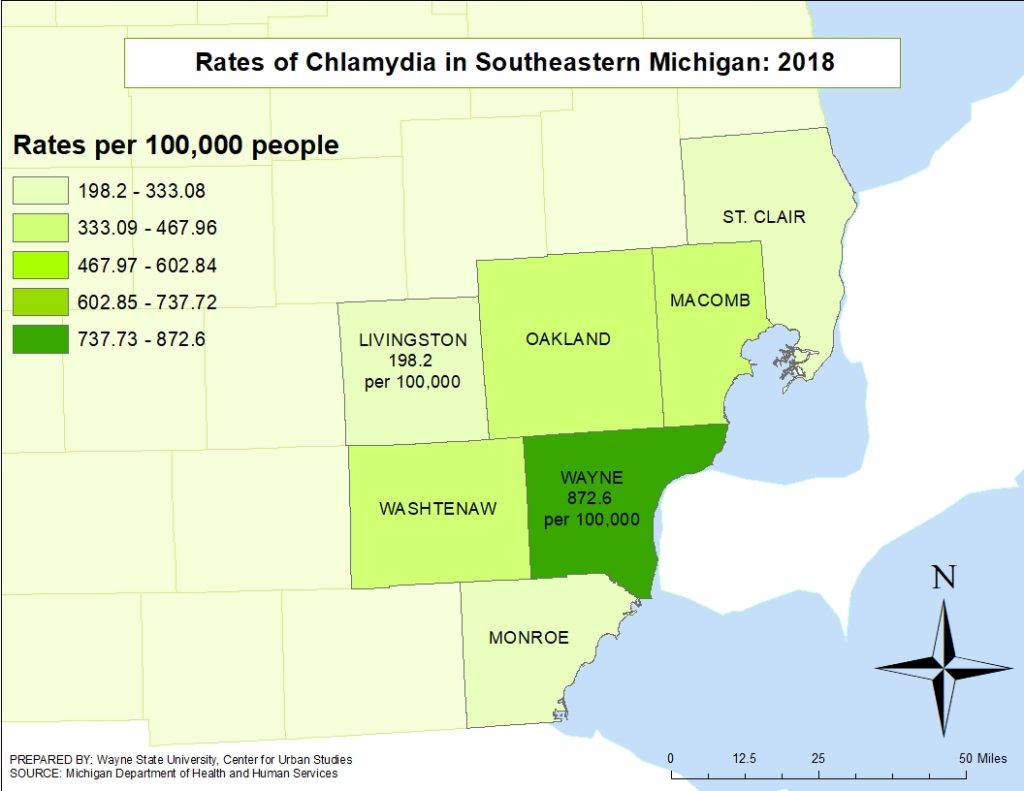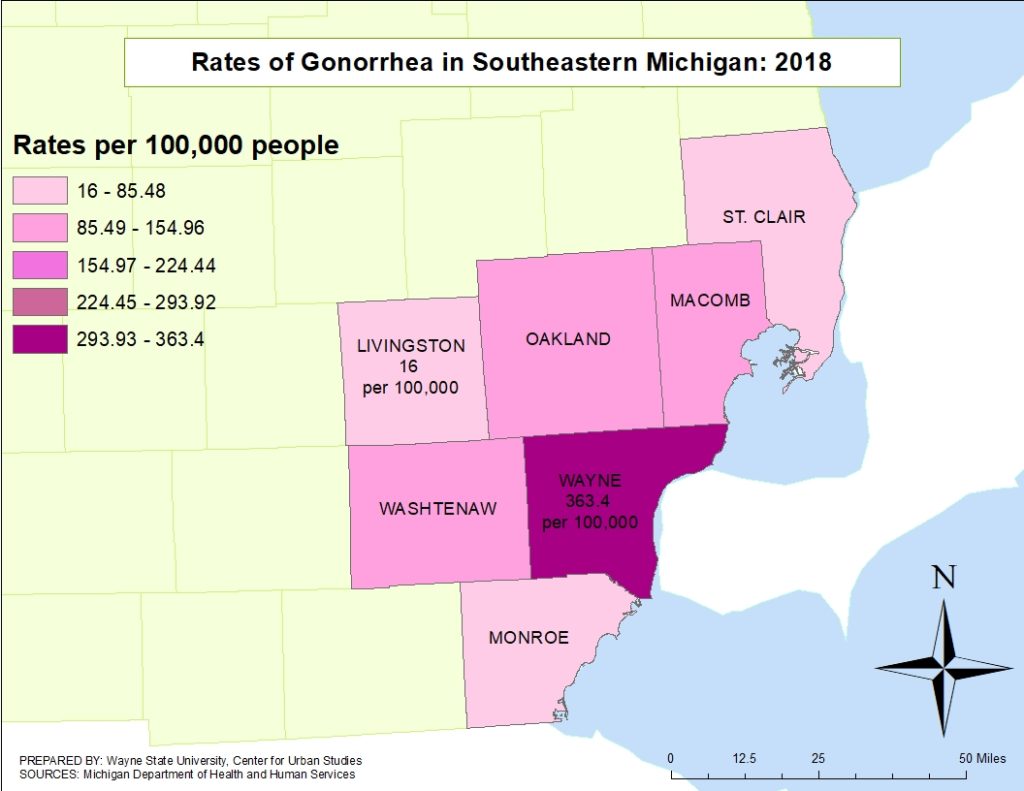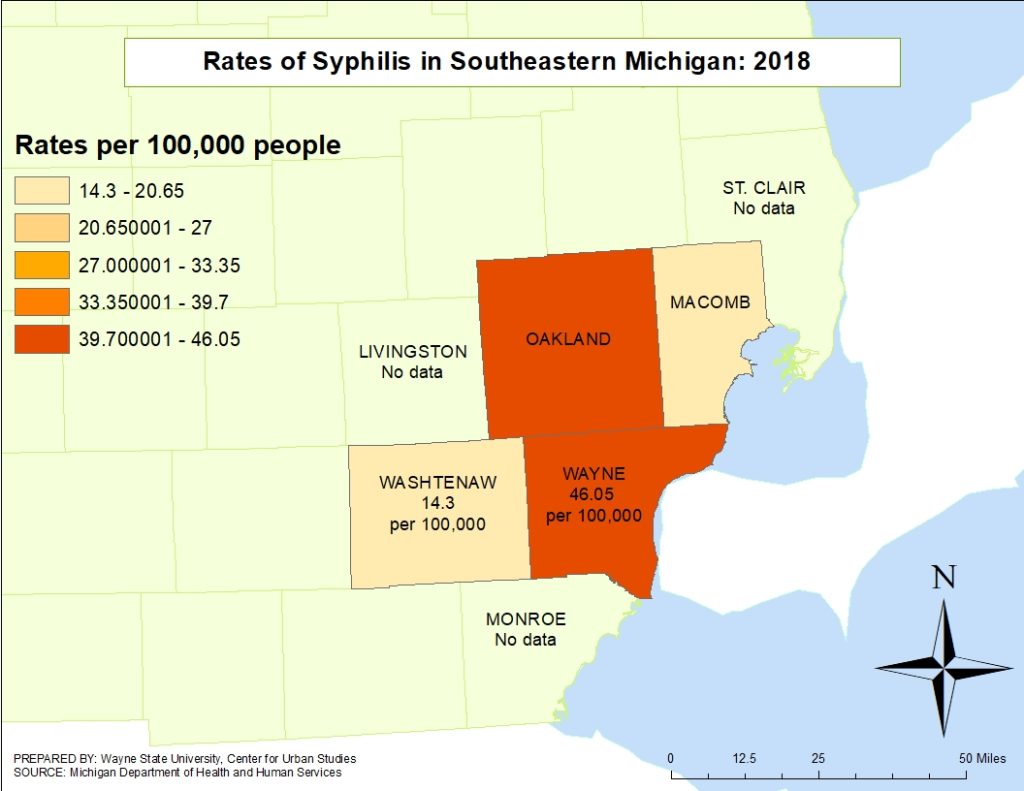Throughout Southeastern Michigan, Wayne County has consistently had the highest sexually transmitted disease (STD) rates since at least 2009, according to the Michigan Department of Health and Human Services. Below are three charts showing the rates per 100,000 people for chlamydia, gonorrhea and syphilis. All three charts show that the rate at which individuals in Wayne County have one of those STDs is much higher than any of the neighboring counties. Additionally, Livingston County had such low numbers of sexually transmitted infections accounted for there was no data available for some of the STDs.
The first chart below shows the rates people with chlamydia per 100,000 between 2009 and 2018 for the counties in Southeastern Michigan. Wayne County’s rate peaked at 1,213.6 in 2010 but has since declined to 872.6 per 100,000 people in 2018. The sheer number of chlamydia cases reported in Wayne County in 2018 was 15,305. The county with the lowest number of cases per capita was Livingston County. In 2009 the rate was 112.1 cases per 100,00 people and by 2018 that number increased to 312.5 cases per people. In 2018, 318 cases of chlamydia were reported in Livingston County. Unlike with Wayne County, all the other counties in the region experienced an overall increase in the rate at which people were contracting the infection. Of the three types of STDs explored in this post, chlamydia has the highest number of cases reported, making it the most common.
The national trend also appears to show an increase in the number of people becoming infected with an STD. Although no specific reason was given for the decrease in Wayne County’s number it could be related to an increase in information related to sexual education and access to condoms, which are the primary prevention source beyond abstinence.


Wayne County again had the highest rate for the STD examined in the chart below, which is gonorrhea. However, the trend for this infection is not as similar to the trend for chlamydia. For Wayne County, there were 457.2 gonorrhea cases per 100,000 people reported in 2009, and while that number dipped to 213.4 cases per 100,000 people in 2014 it has since increased to 363.4 cases per 100,000 people. While it is fair there has been an overall decrease in the amount of gonorrhea cases reported over the last 10 years, there seems to be a trend of those numbers rising. In 2018 in Wayne there was a total of 6,374 gonorrhea cases reported.
St. Clair County regularly had the lowest rates reported for gonorrhea infections between 2009 and 2018. In 2009 there were 79 cases reported per 100,000 people and in 2018 that number decreased to 45.2 (72 cases total). However, the number of cases dropped so low in 2014 and 2015 a rate wasn’t able to be calculated, again showing the trend where there has been an overall decrease in cases, but the numbers are beginning to tick up.
For some counties, like Macomb, Oakland and Washtenaw, the per capita number has increased above the number reported in 2009. Washtenaw County had the second highest per capita number of cases reported throughout the time frame. In 2018 the gonorrhea rate was 141 cases per 100,000 people (523 cases). While an overall increase from the 2009 rate of 95.8 cases 100,000 people, it is more than 200 points below the Wayne County rate.


Syphilis has the lowest rate among the sexually transmitted infections examined in this post, so low that only data for Wayne, Macomb Oakland and Washtenaw counties was available. Wayne County had the highest rates between 2009 and 2018. In 2009 Wayne County had a rate of 17.4 cases per 100,000 people and in 2018 that increased to 44.8 cases per 100,000 people, or a total of 786 cases. Of the counties with reported data it was Macomb County with the lowest rates, in 2011 (the first year when per capita data was reported) the rate was 6.8 cases per 100,000 people and in 2017 (the most recent year for data) the rate increased to 11.8 syphilis cases per 100,000 people, or 148 cases.


Overall the trend remains that the number of STD cases continue to rise, with the 26 years of age and under population experiencing the largest number of cases, according to the Michigan Department of Health and Human Services. In the charts above you will see that Washtenaw County regularly falls in second or third in terms of rankings for the per capita rates of any one of the three infections discussed above. This likely has to do with the fact that Washtenaw County is home to both the University of Michigan and Eastern Michigan University.
Overall, experts believe part of the rise is related to misinformation or overall lack of information on STDs. They urge those who are sexually active to be open and honest with both their partner(s) and health care providers about regular testing, and proper treatment if necessary, to ensure the STD isn’t spread to additional people. Information on ways to best prevent STDs, such as use of condoms, regular testing and abstinence, are also encouraged to be discussed more with all individuals, particularly those under the age of 26.
For more information on STD testing, prevention and other information click here.